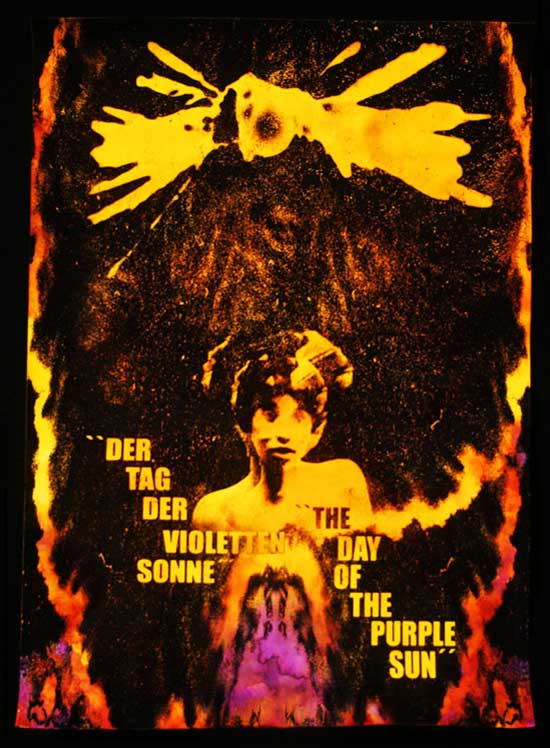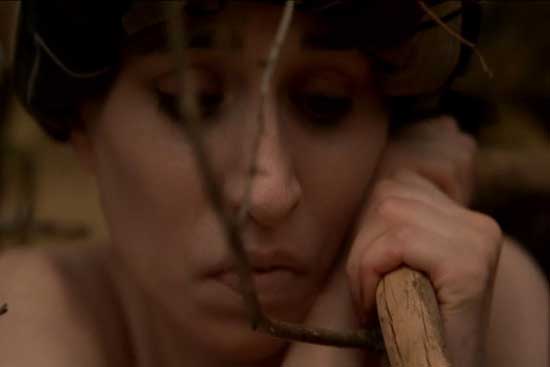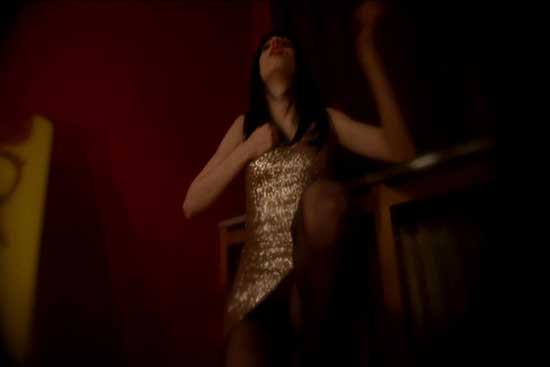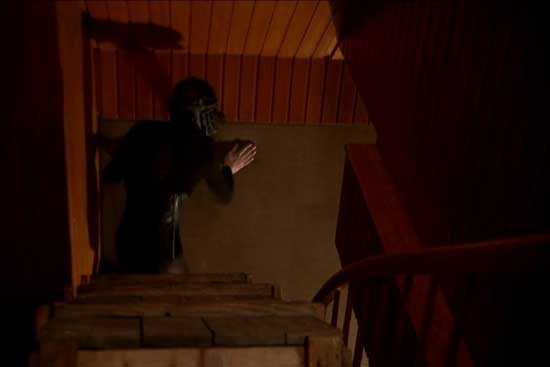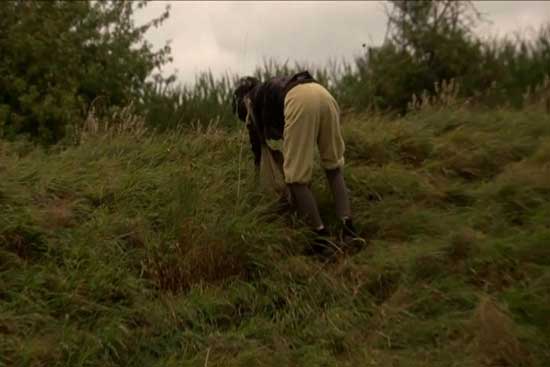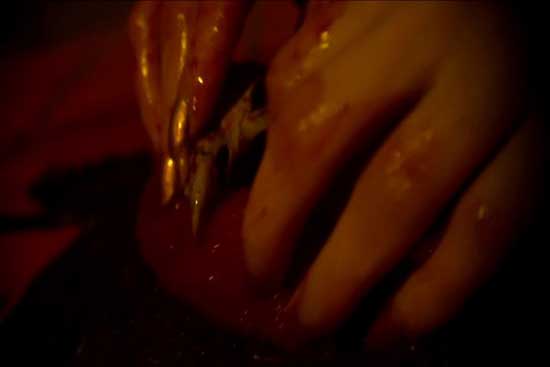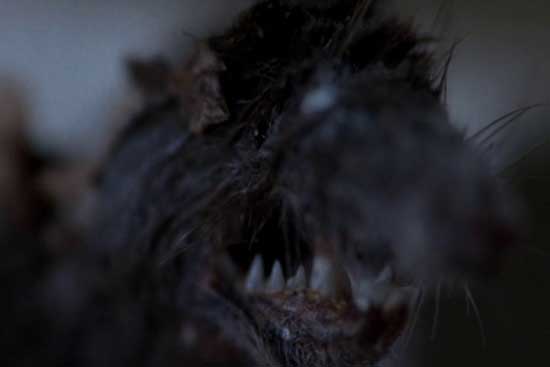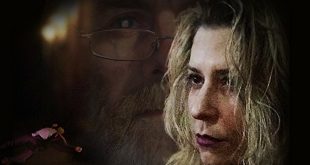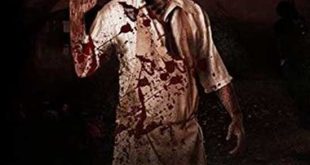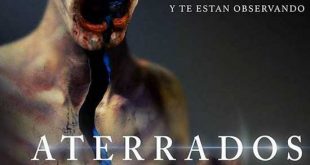SYNOPSIS:
”THE DAY OF THE PURPLE SUN”: The cosmos of the incurable Margarethe. Her journey through the mysteries of the Egypt underworld. Will she be coming forth by day?
REVIEW:
There is a very specific style to the films of Carsten Frank and Margarethe von Stern, but it is one that would be very difficult to put into words. There is no linear storyline, nor is there much in the way of dialogue. Any speaking that does occur comes across as stream of consciousness thoughts from von Stern’s character’s mind. In fact, there could be an argument made that the events of the films could exist primarily inside her mind, as there is a dream-like quality to them. Death and sickness always seem to be in the air, and the visuals are raw and nightmarish, showing nature through both a beautiful and a grotesque lens, and often times melding the artificial with the organic. These qualities were all on display in Frank’s Secrets of a Soul (2012) and Bestie! (2013), and The Day of the Purple Sun is no different.
Technically, The Day of the Purple Sun is a two-part film, each part about 68 minutes long, but it’ll be discussed as a whole here. Directed by Frank and written by Frank and von Stern, this latest release from Frank’s Quiet Village Films dips into misery and sickness right from the start. This seems fitting, as the “purple sun” of the title is often referenced as an omen of pain and bloodshed. Just as in Frank’s previous two films, Margarethe von Stern plays a character named Margarethe. Whether this character is the same in all three films is unknown, but there are hints that this is a possibility. Right from the start of this film she looks troubled, pained. She has a distant look in her eyes, like she’s not really there, like maybe something is wrong. When she looks at scans of her skull and brain, it becomes obvious that something is very wrong. She begins to ask herself questions: “What will happen to me?” Soon, Margarethe sees death and decay all around her in the form of dead animals.
There are parallels that can be drawn between Margarethe and Esther (Marina de Van) from In My Skin. Whereas Esther becomes obsessed with the feeling of disconnect she has from her own body and searches for answers, Margarethe knows the reason for her distress, but is not yet able to come to terms with it. Just as Esther cuts into her own skin, Margarethe pulls at the skin on her arm, and at times struggles with her leg as if it does not belong to her, as she is suddenly unable to will it to function properly. The big difference between the two characters is how they react and cope with their struggles. De Van’s Esther mutilates herself in the ultimate demand for/taking back of control. Margarethe recognizes her increasing lack of control of herself, and begins looking to Egyptian mysticism and rituals, bringing the remnants of the dead animals she finds back home and piecing them back together within a mummy-like gauze wrapping, perhaps her own grasp for some semblance of control. She calls each one Osiris, after the Egyptian god of the afterlife and rebirth – she also says that she hopes to return as Re (or Ra), the sun god and the creator. And she speaks of death’s simplicity, resigning herself to the fact that perhaps this disease that is taking her over is one she cannot defeat.
While the first part of The Day of the Purple Sun dwells in death and darkness, part two is full of chaos and struggles, both internal and spiritual. A masked man (Anubis? played by Frank) carries Margarethe’s body from her bed into an empty room, strips her, and wraps her partially in gauze, just as she did the dead animals. It is here that what we know as Margarethe seems to split into many forms: the physical, ailing (dead?) Margarethe is placed inside a coffin; a healthy, attractive version of her still smiles; a symbol-covered spirit steps out of the physical body; and a raw, dirty, almost feral embodiment seems to also split once it runs outside. These seem to represent the different aspects of her, her health, her spirit, her sickness, some at odds with others.
As with Frank’s previous films, The Day of the Purple Sun is at times beautiful, disturbing, grotesque, and nightmarish, sometimes all at once. The camera work is fantastic, again finding shots that manage to bring a sense of the sublime to close-up scenes of insects or decaying animal carcasses. Just as in Secrets of a Soul, the organic artwork of animal parts and feathers and bones mixed with wire and metal makes an appearance, and it is just as unsettling the second time around. Frank experiments with lighting and double exposures to a high degree of success, adding another layer to his already intriguing style. And yet again, von Stern mesmerizes in her emotive, non-verbal actions, her face saying the thousand words in expression alone, and her body twisting and contorting and portraying fear and pain and sorrow.
Carsten Frank may often be talked about in terms of his role in the films of Marian Dora (Cannibal, Melancholie der Engel), but his work behind the camera is speaking loudly and making a statement that demands to be heard. Margarethe von Stern has shown that she is an actress that is willing to put everything on the screen, pushing herself until she’s satisfied. With The Day of the Purple Sun, the duo has again crossed the boundaries and created a piece of art bound by no rules and no limits.
 Horror News | HNN Official Site | Horror Movies,Trailers, Reviews
Horror News | HNN Official Site | Horror Movies,Trailers, Reviews
